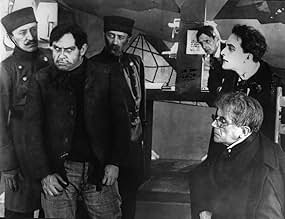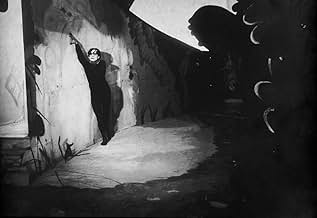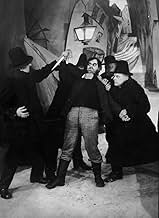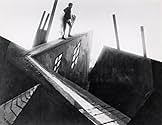IMDb रेटिंग
8.0/10
74 हज़ार
आपकी रेटिंग
कृत्रिम निद्रावस्था में लानेवाला डॉ कैलिगरी एक सोमनामबुलिस्ट, सीज़र का उपयोग करता है।कृत्रिम निद्रावस्था में लानेवाला डॉ कैलिगरी एक सोमनामबुलिस्ट, सीज़र का उपयोग करता है।कृत्रिम निद्रावस्था में लानेवाला डॉ कैलिगरी एक सोमनामबुलिस्ट, सीज़र का उपयोग करता है।
- पुरस्कार
- 2 जीत और कुल 1 नामांकन
Friedrich Feher
- Franzis
- (as Friedrich Fehér)
Hans Heinrich von Twardowski
- Alan
- (as Hans Heinz v. Twardowski)
Rudolf Lettinger
- Dr. Olsen
- (as Rudolph Lettinger)
Rudolf Klein-Rogge
- Ein Verbrecher
- (बिना क्रेडिट के)
- …
Hans Lanser-Ludolff
- Ein Alter Mann
- (बिना क्रेडिट के)
- …
Henri Peters-Arnolds
- Ein Junger Arzt
- (बिना क्रेडिट के)
- …
Ludwig Rex
- Ein Mörder
- (बिना क्रेडिट के)
- …
Elsa Wagner
- Die Wirtin
- (बिना क्रेडिट के)
- …
फ़ीचर्ड समीक्षाएं
I vowed to see more horror films this year, and this was recommended to me, initially I was a little dubious with it being a hundred plus years old, and a silent film, but I have to say I have a real appreciation for it.
Without a doubt, this film must be the inspiration for the whole horror genre, a genre that scares and shocks people to this day, you can only I shine the profound effect that this film must have had on viewers back in its time.
Hugely atmospheric and creepy, if I'm honest, it is slow, and you do need to concentrate, or you'll lose it, no texting or phone play, it is a fairly intense watch, best of all is the ending, which really does come as a surprise, it's something of a twist.
It is definitely not for everyone, and if you're used to modern horror, you may find ten minutes of it an arduous task, but having watched Nose earlier in the year, I have a real appreciation for this early gem.
An admirable film, 8/10.
Without a doubt, this film must be the inspiration for the whole horror genre, a genre that scares and shocks people to this day, you can only I shine the profound effect that this film must have had on viewers back in its time.
Hugely atmospheric and creepy, if I'm honest, it is slow, and you do need to concentrate, or you'll lose it, no texting or phone play, it is a fairly intense watch, best of all is the ending, which really does come as a surprise, it's something of a twist.
It is definitely not for everyone, and if you're used to modern horror, you may find ten minutes of it an arduous task, but having watched Nose earlier in the year, I have a real appreciation for this early gem.
An admirable film, 8/10.
10wmackey
Dr. Caligari presents the viewer with a frightening vision of the world through the lens of German Expressionism.
I cannot recommend this film highly enough. It's truly fascinating. And, it really (really) is an art film, since it purposefully and strikingly exhibits the new art of the German inter-war milieu. So, be prepared for an other-worldly excursion into the "total work of art," or Gesamtkunstwerk, of this monumental and influential film.
This film is best seen at night, alone, and with the modern soundtrack which is available on the fully restored version. If the DVD you're watching does not have (a) choice of two soundtracks (traditional music and much-scarier modern track), (b) tinted inter-titles set in a surrealistic (actually expressionistic) font, and (3) is fairly high quality, then send it back and get the restored version. The quality and completeness of silent films are a major factor in experiencing the art form as it was meant to be experienced. The modern sound track in Dr. Caligari makes the film much more accessible for modern audiences (the eerie effects in the modern track heighten the feel of the film for the modern viewer) - try both tracks, you'll see.
It's surprising how frightening and impactful this film can be. You will have dreams about it, I promise. These between-the-wars German films are riddled with creepy foreshadowing for us in the present, who know what was about to happen in Germany.
Anyway, I think the film is best viewed with NO NOTICE. You don't really want to know the plot (the meaning of the end of the film can be interpreted in radically different ways - keep that in mind when it happens). Only one note - artistically the German Expressionist movement is worth reading about after you see the film - you'll notice the theme of "death and the maiden" woven into this artwork. Also, this film is the direct ancestor of films like "Nightmare Before Christmas" and a lot more - you'll recognize the Expressionist look in many presentations in television and film.
WARNING - I would NOT show this film to children. It's very subtly and psychologically undermining - you'll be thinking and freaking about this thing for months to come - such a thing shouldn't be experienced by children - it's an adult, art film (no, not that kind) made for adults.
I cannot recommend this film highly enough. It's truly fascinating. And, it really (really) is an art film, since it purposefully and strikingly exhibits the new art of the German inter-war milieu. So, be prepared for an other-worldly excursion into the "total work of art," or Gesamtkunstwerk, of this monumental and influential film.
This film is best seen at night, alone, and with the modern soundtrack which is available on the fully restored version. If the DVD you're watching does not have (a) choice of two soundtracks (traditional music and much-scarier modern track), (b) tinted inter-titles set in a surrealistic (actually expressionistic) font, and (3) is fairly high quality, then send it back and get the restored version. The quality and completeness of silent films are a major factor in experiencing the art form as it was meant to be experienced. The modern sound track in Dr. Caligari makes the film much more accessible for modern audiences (the eerie effects in the modern track heighten the feel of the film for the modern viewer) - try both tracks, you'll see.
It's surprising how frightening and impactful this film can be. You will have dreams about it, I promise. These between-the-wars German films are riddled with creepy foreshadowing for us in the present, who know what was about to happen in Germany.
Anyway, I think the film is best viewed with NO NOTICE. You don't really want to know the plot (the meaning of the end of the film can be interpreted in radically different ways - keep that in mind when it happens). Only one note - artistically the German Expressionist movement is worth reading about after you see the film - you'll notice the theme of "death and the maiden" woven into this artwork. Also, this film is the direct ancestor of films like "Nightmare Before Christmas" and a lot more - you'll recognize the Expressionist look in many presentations in television and film.
WARNING - I would NOT show this film to children. It's very subtly and psychologically undermining - you'll be thinking and freaking about this thing for months to come - such a thing shouldn't be experienced by children - it's an adult, art film (no, not that kind) made for adults.
With a story as twisted, buckled and demented as the scenery and set design, and a tortured score to boot, was the lunatic in charge of the asylum? Must have been a moment to remember coming across this cinematic marvel back in 1920. I wonder how many of today's pieces of cinema will stand the test of 100 years, albeit with a lot more competition.
10Gafke
Made in 1919, "The Cabinet of Doctor Caligari" was literally years ahead of its time and remains a triumphant accomplishment in the genre of German Expressionism. Remembered mainly for its stunning sets, which featured crooked buildings and twisted landscapes, "Cabinet" also boasts one of the first attempts at a twist ending, something quite new and shocking for its time.
Told mainly from the point of view of Francis, a young man who lives in the small village of Holstenwall, Germany, "Cabinet" tells the tale of murder and madness which seems to accompany the arrival of a carnival. Francis and his best friend Alan go to the carnival and are presented with the sideshow attraction Cesare the Somnambulist, a gaunt and hideous young man who spends his life sleeping in a coffin-like cabinet and seems able to predict the future when awake. Cesare (played by a young Conrad Veidt, who later went on to play the evil Nazi general in Casablanca) informs Alan that he will soon die, and indeed, Alan is found murdered the next morning. Suspicion turns to the eerie somnambulist and his strange keeper, a man called Caligari. As Francis desperately tries to solve the mystery and find his friends killer, it seems that the beautiful young Jane, beloved by both Alan and Francis, has been targeted as the next victim.
This is a genuinely creepy film which delves deep into the mysteries of the abnormal mind...an uncomfortable journey to say the least. Everyone is suspect and, in the end, we must ask ourselves: "who is really the mad one here?"
Subtle and ingenious, we see the world the way an insane person might see it; warped and confused, a nightmarish terrain where nothing makes sense and balance is not to be found.
The impact of this film is still being felt and seen today, and for good reason. It is a shocking, disturbing masterpiece. I cannot recommend it highly enough.
Told mainly from the point of view of Francis, a young man who lives in the small village of Holstenwall, Germany, "Cabinet" tells the tale of murder and madness which seems to accompany the arrival of a carnival. Francis and his best friend Alan go to the carnival and are presented with the sideshow attraction Cesare the Somnambulist, a gaunt and hideous young man who spends his life sleeping in a coffin-like cabinet and seems able to predict the future when awake. Cesare (played by a young Conrad Veidt, who later went on to play the evil Nazi general in Casablanca) informs Alan that he will soon die, and indeed, Alan is found murdered the next morning. Suspicion turns to the eerie somnambulist and his strange keeper, a man called Caligari. As Francis desperately tries to solve the mystery and find his friends killer, it seems that the beautiful young Jane, beloved by both Alan and Francis, has been targeted as the next victim.
This is a genuinely creepy film which delves deep into the mysteries of the abnormal mind...an uncomfortable journey to say the least. Everyone is suspect and, in the end, we must ask ourselves: "who is really the mad one here?"
Subtle and ingenious, we see the world the way an insane person might see it; warped and confused, a nightmarish terrain where nothing makes sense and balance is not to be found.
The impact of this film is still being felt and seen today, and for good reason. It is a shocking, disturbing masterpiece. I cannot recommend it highly enough.
It struck me last night that I've never seen a serious silent film. Everyone's seen a silent comedy: Charlie Chaplin, Buster Keaton, the Keystone Cops... They've all been immortalized in the minds of every film viewer, and I enjoy them as much as anyone. But it seems a strange and almost disrespectful lack to never have seen anything but comedy; so many silent films were created, and the only ones I've seen starred waddling tramps.
It was partially for that reason that I rented this movie. I had read about it on a film review site (the name of which escapes my memory) and decided it was worth the half-hour drive to the video store. The basic premise is that of a man relating a story that happened to him and his friends - their unnerving discovery of a crazed mountebank, Dr. Caligari, and his prophetic sleepwalker. It follows a series of murders and growing madness, keeping you in constant suspense and confusion until the very last scene.
There's a period of adjustment when watching it - unfortunately necessary for a modern audience. The titles seem too slow. The camera seems to hold on scenes too long. The makeup on the actors' faces seem ghostly and horrible - even on the hero.
But before long, the movie has you in its grip. You spend time staring at the architecture - buildings, doors, and windows that would have been funny in a Dr. Seuss book. In the film, they make you uneasy. The whole atmosphere is of a world gone wrong; like a dream worthy of Salvador Dalí. Nothing is square or straight. The buildings loom in on you; windows sweep upward, slanted or curved; doors are obscenely angled holes beckoning you to enter and be trapped inside.
Throughout, the story defies expectations. Small plot twists confuse and mislead you until the final surprise, completely tearing down everything you thought the movie was about. Strange shadows and shots from inside alleys paint the film's world as something terrible, never allowing you a normal look at the village, never allowing you to enjoy the quaintness of it. Through it all, the grinning, hunched figure of Dr. Caligari hangs in your mind, pushing out rational thought.
The movie is well worth your time; there's a certain pleasure in trying to capture the feeling of terror an early audience, unaccustomed to the visual effects we see every day, would have had the first time they saw this movie. It's an intellectual terror in the grand old style, giving you the same thrill you get from reading Frankenstein or Dr. Jekyll and Mr. Hyde. At the risk of sounding cliché: two thumbs up!
It was partially for that reason that I rented this movie. I had read about it on a film review site (the name of which escapes my memory) and decided it was worth the half-hour drive to the video store. The basic premise is that of a man relating a story that happened to him and his friends - their unnerving discovery of a crazed mountebank, Dr. Caligari, and his prophetic sleepwalker. It follows a series of murders and growing madness, keeping you in constant suspense and confusion until the very last scene.
There's a period of adjustment when watching it - unfortunately necessary for a modern audience. The titles seem too slow. The camera seems to hold on scenes too long. The makeup on the actors' faces seem ghostly and horrible - even on the hero.
But before long, the movie has you in its grip. You spend time staring at the architecture - buildings, doors, and windows that would have been funny in a Dr. Seuss book. In the film, they make you uneasy. The whole atmosphere is of a world gone wrong; like a dream worthy of Salvador Dalí. Nothing is square or straight. The buildings loom in on you; windows sweep upward, slanted or curved; doors are obscenely angled holes beckoning you to enter and be trapped inside.
Throughout, the story defies expectations. Small plot twists confuse and mislead you until the final surprise, completely tearing down everything you thought the movie was about. Strange shadows and shots from inside alleys paint the film's world as something terrible, never allowing you a normal look at the village, never allowing you to enjoy the quaintness of it. Through it all, the grinning, hunched figure of Dr. Caligari hangs in your mind, pushing out rational thought.
The movie is well worth your time; there's a certain pleasure in trying to capture the feeling of terror an early audience, unaccustomed to the visual effects we see every day, would have had the first time they saw this movie. It's an intellectual terror in the grand old style, giving you the same thrill you get from reading Frankenstein or Dr. Jekyll and Mr. Hyde. At the risk of sounding cliché: two thumbs up!
क्या आपको पता है
- ट्रिवियाWriter Hans Janowitz claims to have gotten the idea for the film when he was at a carnival one day. He saw a strange man lurking in the shadows. The next day he heard that a girl was brutally murdered there. He went to the funeral and saw the same man lurking around. He had no proof that the strange man was the murderer, but he fleshed the whole idea out into his film.
- गूफ़In the wide shot, the sign at the asylum reads "Insane Asylum," in English. In the close-up, the sign is written in German (Kino Blu-ray Disc version, may not be present in all editions of the film).
- इसके अलावा अन्य वर्जनUSA laserdisc reissue restores the original hand-drawn title cards that have been missing from every known print of the film since 1923. When first released on video in the United States, film was in black-and-white, and played back many scenes at double speed and featured different music. Although no scenes were cut out, the running time was reduced to only 51 minutes. The restored version restores the colour-tinting, restores the original title cards, and plays the film back at regular speed, returning the film to its original 69-minute running time.
- कनेक्शनEdited into People Who Die Mysteriously in Their Sleep (2004)
टॉप पसंद
रेटिंग देने के लिए साइन-इन करें और वैयक्तिकृत सुझावों के लिए वॉचलिस्ट करें
विवरण
- रिलीज़ की तारीख़
- कंट्री ऑफ़ ओरिजिन
- भाषा
- इस रूप में भी जाना जाता है
- El gabinete del Dr. Caligari
- फ़िल्माने की जगहें
- उत्पादन कंपनी
- IMDbPro पर और कंपनी क्रेडिट देखें
बॉक्स ऑफ़िस
- बजट
- $18,000(अनुमानित)
- US और कनाडा में सकल
- $8,811
- दुनिया भर में सकल
- $9,297
- चलने की अवधि
- 1 घं 16 मि(76 min)
- ध्वनि मिश्रण
- पक्ष अनुपात
- 1.37 : 1
इस पेज में योगदान दें
किसी बदलाव का सुझाव दें या अनुपलब्ध कॉन्टेंट जोड़ें

















